
User’s Guide
EN
CLASSIC
TM
NOTICE
Do not lubricate this pipette.
The use of lubricant cancels
the warranty of this pipette.

INTRODUCTION
3
2
PIPETMAN® CLASSIC | USER’S GUIDE | PIPETMAN® CLASSIC
Chapter 1
INTRODUCTION
The Pipetting Standard – Gilson's
PIPETMAN® Classic is designed and
manufactured to provide you with a range of
robust, accurate, and precise pipettes.
The PIPETMAN Classic is a fully adjustable,
air-displacement pipette with the selected
volume shown on a digital indicator (volumeter).
Eight models cover a range from 0.2 µL to 10mL,
for many applications:
● P2 and P10: measurement and transfer
of micro-volumes, DNA sequencing, and
enzyme-assays.
● P20, P100, P200, P1000: measurement and
transfer of general aqueous solutions, acids,
and bases.
● P5000, P10mL: measurement and transfer of
large volumes.
Parts Checklist
After unpacking the pipette, verify that
the following items were included and are
undamaged:
● PIPETMAN Classic
● PIPETMAN® Classic User's Guide
● Safety Bag
● Certificate of Conformity (including barcode
sticker)
GLP Features
The serial number
is engraved on the
body of the pipette.
It provides unique
identification of your
pipette and the date
of manufacture;
Ex:AA 10369
The barcode on the
box and the certificate
of conformity provide
traceability of your
pipette.
Figure 1
Serial Number Location
TABLE OF CONTENTS
INTRODUCTION | 3
Parts Checklist | 3
GLP Features | 3
Description | 4
Specifications | 4
SETTING THE VOLUME | 6
PIPETTING | 7
Fit the Tips | 7
Pre-Rinse the Tips | 8
Guidelines for Good Pipetting | 9
ACCESSORIES | 11
TROUBLESHOOTING | 12
Troubleshooting Table | 12
Leak Test | 14
MAINTENANCE | 15
Changing the Tip Ejector | 15
Changing the Tip Holder – No Tools Required | 17
Servicing the Piston Assembly | 17
Cleaning and Decontamination | 18
SPARE PARTS | 21
P2 (F144801) and P10(F144802) | 21
P20 (F123600) and P100(F123615) | 21
P200 (F123601) and P1000(F123602) | 22
P5000 (F123603) and P10mL(F161201) | 22
EC DECLARATION OF CONFORMITY | 24
WARRANTY | 25

INTRODUCTION
INTRODUCTION
5
4
PIPETMAN® CLASSIC | USER’S GUIDEINTRODUCTION | PIPETMAN® CLASSIC
Description
Specifications
PIPETMAN Classic is a high quality
pipette that offers excellent accuracy
and precision. The values provided in the
Maximum Permissible Errors tables were
obtained using PIPETMAN® DIAMOND tips.
These values are guaranteed only when genuine
PIPETMAN® DIAMOND tips are used.
Each pipette is inspected and validated by
qualified technicians in accordance with the
Gilson Quality System. Gilson declares that
its manufactured pipettes comply with the
requirements of the ISO8655 standard by type
testing. The adjustment is carried out under
strictly defined and monitored conditions
(ISO8655-6).
Color-coded
push button
Thumbwheel
Tip ejector
button
Body or
handle
Connecting
nut
PIPETMAN®
DIAMOND tip
Tip
holder
Tip ejector
Figure 2
PIPETMAN® Classic
Maximum Permissible Errors
The data provided in the following tables
conform to the ISO8655-2 Standard. With
a precise pipetting technique (refer to
Guidelines for Good Pipetting on page 9) the
P2 model may be used to aspirate volumes as low
as 0.1µL and the P10 model as low as 0.5 µL.
P2 WITH D10 OR DL10 TIPS (P/NF144801)
VOLUME*
GILSON ISO 8655
SYSTEMATIC
ERROR
RANDOM
ERROR
SYSTEMATIC
ERROR
RANDOM
ERROR
Min 0.2 ±0.024 ≤0.012 ±0.08 ≤0.04
0.5 ±0.025 ≤0.012 ±0.08 ≤0.04
Max 2 ±0.030 ≤0.014 ±0.08 ≤0.04
P10 WITH D10 OR DL10 TIPS (P/NF144802)
Min 1 ±0.025 ≤0.012 ±0.12 ≤0.08
5 ±0.075 ≤0.030 ±0.12 ≤0.08
Max 10 ±0.100 ≤0.040 ±0.12 ≤0.08
P20 WITH D200 TIPS (P/NF123600)
Min 2 ±0.10 ≤0.03 ±0.20 ≤0.10
5 ±0.10 ≤0.04 ±0.20 ≤0.10
10 ±0.10 ≤0.05 ±0.20 ≤0.10
Max 20 ±0.20 ≤0.06 ±0.20 ≤0.10
P100 WITH D200 TIPS (P/NF123615)
Min 20 ±0.35 ≤0.10 ±0.80 ≤0.30
50 ±0.40 ≤0.12 ±0.80 ≤0.30
Max 100 ±0.80 ≤0.15 ±0.80 ≤0.30
P200 WITH D200 OR D300 TIPS (P/NF123601)
Min 50 ±0.50 ≤0.20 ±1.60 ≤0.60
100 ±0.80 ≤0.25 ±1.60 ≤0.60
Max 200 ±1.60 ≤0.30 ±1.60 ≤0.60
P1000 WITH D1000 OR D1200 TIPS (P/NF123602)
Min 200 ±3 ≤0.06 ±8 ≤3.0
500 ±4 ≤1.0 ±8 ≤3.0
Max 1000 ±8 ≤1.5 ±8 ≤3.0
P5000 WITH D5000 TIPS (P/NF123603)
Min 1000 ±12 ≤3 ±40 ≤15
2000 ±12 ≤5 ±40 ≤15
Max 5000 ±30 ≤8 ±40 ≤15
P10ML WITH D10ML TIPS (P/NF161201)
Min 1 ±30 ≤6 ±60 ≤30
2 ±30 ≤6 ±60 ≤30
5 ±40 ≤10 ±60 ≤30
Max 10 ±60 ≤16 ±60 ≤30
*All Values in Microliters

PIPETTING
SETTING THE VOLUME
7
6
PIPETMAN® CLASSIC | USER’S GUIDESETTING THE VOLUME | PIPETMAN® CLASSIC
Chapter 2
SETTING THE VOLUME
The volume of liquid to be
aspirated is set using the
volumeter. The dials are
colored either black or
red to indicate the
position of the decimal
point, depending on the
model (see examples).
The volume is set by
turning the thumbwheel
or the push button. The
push button makes it
easier and quicker to
set volumes, especially
when wearing gloves.
The thumbwheel may be
turned to slowly reach the
required setting.
To obtain maximum
accuracy when setting the
volume:
● When decreasing the
volume setting, slowly
reach the required
setting, making
sure not to pass the
setting.
● When increasing the
volume setting, pass
the required value by
1/3 of a turn and then
slowly decrease to reach
the volume, making sure
not to pass the setting.
MODEL
COLOR OF VOLUMETERNUMBERS
BLACK RED INCREMENT
P2 µL 0.01 µL 0.002 µL
P10 to P20 µL 0.1 µL 0.02 µL
P100–P200 µL — 0.2 µL
P1000–P5000 0.01 mL mL 0.002 mL
P10mL mL 0.1 mL 0.02 mL
Figure 3
Dial Colors by Model
Push button
Thumbwheel
Figure 4
Location of
Push Button and
Thumbwheel
Chapter 3
PIPETTING
While many brands of tips can be used with
the PIPETMAN® Classic, it is recommended
to use PIPETMAN® DIAMOND for optimum
performance. These tips, made from pure
polypropylene have the Gilson logo engraved
on their collar, ensuring that you have a genuine
Gilson product. Plastic tips are for a single
application—they must not be cleaned for reuse.
PIPETMAN Classic can also be used with the main
tip brands.
Fit the Tips
To fit a new PIPETMAN DIAMOND tip, push the
tip holder into the tip using a slight twisting
motion to ensure a firm and airtight seal.
NOTE
For the P2 and P10 models, a dual-
position adapter (plastic) is required
to fit DL10 tips (longtips) or D10 tips
(short tips). The metallic rod of the tip
ejector is shaped so that the adapter
may be clipped to it in either position.
P2 and P10 models
are delivered with
the adapter in place,
positioned in the longer
slot, and ready to use
DL10tips. When D10 tips
(which are shorter) are
used, the adapter must
be repositioned in the
shorter slot as follows:
1. Pull the adapter
down from the
metallic rod.
2. Turn the adapter
180°.
3. Refit the adapter so
that the end of the
metallic rod engages
the shorter slot of
the adapter.
Short
tips
Long
tips
Figure 5
Dual-Position Adapter
for P2 and P10

PIPETTING
PIPETTING
9
8
PIPETMAN® CLASSIC | USER’S GUIDEPIPETTING | PIPETMAN® CLASSIC
Pre-Rinse the Tips
Some liquids (e.g., protein-containing solutions
and organic solvents) can leave a film of liquid
on the inside wall of the tip; pre-rinse the tip to
minimize any errors that may be related to this
phenomenon.
Pre-rinsing consists of aspirating the first
volume of liquid and then dispensing it back to
waste. Subsequent volumes that you pipette
will have levels of accuracy and precision within
specifications.
Aspirate
1. Press the push button to the first stop (this
corresponds to the set volume of liquid).
2. Hold the pipette vertically and
immerse the tip in the liquid (refer to
Guidelines for Good Pipetting on page 9).
Release the push button slowly and smoothly
(to top position) to aspirate the set volume of
liquid. Wait one second, the time depends on
the model (refer to the table), then withdraw
the pipette tip from the liquid. You may wipe
any droplets away from the outside of the tip
using a medical wipe; however, if you do so,
take care to avoid touching the tip’s orifice.
First stop
Second stop
Figure 6
Pipetting Motion - Aspirate and Dispense
Dispense
1. Place the end of the tip against the inside
wall of the recipient vessel (at an angle of 10°
to 40°).
2. Press the push button slowly and smoothly
to the first stop.
3. Wait for at least a second, then press the
push button to the second stop to expel
any residual liquid from the tip. Keep the
push button pressed fully down and (while
removing the pipette) draw the tip along the
inside surface of the vessel.
4. Release the push button smoothly. Eject the
tip by pressing firmly on the tip of the ejector
button.
Guidelines for Good Pipetting
MODEL
IMMERSION DEPTH
(MILLIMETERS)
WAIT TIME
(SECONDS)
P2 1 1
P10 1 1
P20 2–3 1
P100 2–4 1
P200 2–4 1
P1000 2–4 2–3
P5000 3–6 4–5
P10mL 5–7 4–5
1. Make sure that you operate the push button
slowly and smoothly.
2. When aspirating, keep the tip at a constant
depth below the surface of the liquid (refer
to the table).
3. Change the tip before aspirating a different
liquid, sample, or reagent.
4. Change the tip if a droplet remains at the
end of the tip from the previous pipetting
operation.
5. Each new tip should be pre-rinsed with the
liquid to be pipetted.

ACCESSORIES
PIPETTING
11
10
PIPETMAN® CLASSIC | USER’S GUIDEPIPETTING | PIPETMAN® CLASSIC
6. Liquid should never enter the tip holder; to
prevent this:
○ press and release the push button slowly
and smoothly,
○ never turn the pipette upside down,
○ never lay the pipette on its side when
there is liquid in the tip.
7. If you use the same tip with a higher volume,
pre-rinse the tip.
8. For volatile solvents you should saturate the
air cushion in your pipette by aspirating and
dispensing the solvent repeatedly before
aspirating the sample.
9. When the temperature of the liquid is
different from the ambient temperature,
pre-rinse the tip several times before use.
10. You may remove the tip ejector (refer to
Changing the Tip Ejector on page 15) to
aspirate from very narrow tubes.
11. After pipetting acids or other corrosive
liquids that emit vapors, remove the tip
holder, rinse the piston, O-ring, and seal with
distilled water. For the P1000 model, use a
specific tip holder equipped with a filter to
increase the lifetime of the piston (refer to
ACCESSORIES on page 11).
12. Do not pipette liquids with temperatures
above 70°C or below 4°C. The pipette can
be used between +4°C and +40°C but
the specifications may vary according to
the temperature (refer to the ISO 8655-2
standard for conditions of use).
Chapter 4
ACCESSORIES
To make pipetting more comfortable and more
secure, Gilson has developed several accessories:
Pipette stands allow users to store pipettes
vertically to avoid the possibility of liquid running
back into the pipette.
DESCRIPTION PART NUMBER
CARROUSEL™ Pipette
stand (7 pipettes) F161401
TRIO™ stand (3 pipettes) F161405
SINGLE™ pipette holder F161406
To identify or personalize your pipette, Coloris™
clips are available:
DESCRIPTION
PART
NUMBER
COLORIS™ clips (mixed colors set of 10) F161301
COLORIS™ clips (red, set of 10) F161302
COLORIS™ clips (yellow, set of 10) F161303
COLORIS™ clips (green, set of 10) F161304
COLORIS™ clips (blue, set of 10) F161305
COLORIS™ clips (white, set of 10) F161306
With The JIMMY™, hands free microtube opener,
you can open both snap-cap and screw-cap
microtubes.
DESCRIPTION PART NUMBER
THE JIMMY™ (set of 3) F144983
To protect the piston when pipetting corrosive
liquids, you can use a specific tip holder and filter
for the model P1000:
DESCRIPTION PART NUMBER
Corrosion protection kit
(tip holder + a bag of 10 filters) F144570

TROUBLESHOOTING
TROUBLESHOOTING
13
12
PIPETMAN® CLASSIC | USER’S GUIDETROUBLESHOOTING | PIPETMAN® CLASSIC
Chapter 5
TROUBLESHOOTING
A quick inspection of the pipette may help you to
detect a problem.
NOTE
You may download the 2 Minute
Inspection from the Gilson website
(www.gilson.com), which shows
how to perform a quick diagnosis
of your pipette.
WARNING
Before returning any pipette to
your local Gilson Service Center,
ensure that it is completely
free of chemical, biological, or
radioactive contamination. Refer
to Cleaning and Decontamination
on page 18. Please use the
included safety bag to return the
pipette to your local Gilson Service
Center.
Troubleshooting Table
The following table may help you to identify and
correct the problem you might encounter.
SYMPTOM POSSIBLE CAUSE ACTION
Pipette
is leaking
sample
Damaged tip holder
Replace the tip
holder
Worn O-ring or seal
Replace both
parts
Pipette
won’t
aspirate
Worn O-ring
Replace both
parts
Damaged tip holder
Replace the tip
holder
Connecting nut is
loose
Tighten
connecting nut
Damaged or
corroded piston
Return pipette to
supplier
Improper repair or
assembly
Refer to
page 15
SYMPTOM POSSIBLE CAUSE ACTION
Pipette is
inaccurate
Improper repair or
assembly
Refer to
page 15
Unscrew tip holder
Tighten
connecting-nut
Connecting nut is
loose
Tighten
connecting-nut
Pipette is
not precise
Tip holder is loose
Tighten
connecting nut
Connecting nut is
loose
Tighten
connecting nut
Incorrect operator
technique Operator training
Damaged or
corroded piston
Return pipette to
supplier
Damaged tip holder
Replace the tip
holder
Worn O-ring or seal
Replace both
parts
Tips fall o
or do not fit
correctly
Low quality tips
Use PIPETMAN
DIAMOND tips
Damaged tip holder
Replace the tip
holder
Damaged tip ejector
Replace tip
ejector
Ejector spacer is
missing
Mount the spacer
on the tip ejector
The ejector spacer is
damaged
Replace the
ejector spacer
The tip ejector is
loose
Assemble the tip
ejector properly
The ejector lock is
misaligned
Align the ejector
lock
However, if you can’t solve the problem, contact
your Gilson representative.

MAINTENANCE
TROUBLESHOOTING
15
14
PIPETMAN® CLASSIC | USER’S GUIDETROUBLESHOOTING | PIPETMAN® CLASSIC
Leak Test
This test may be performed at any time to check
that the pipette does not leak, especially after
performing a maintenance or decontamination
procedure. If a pipette fails this test, replace
the O-ring and seal. After making sure that the
pipette is correctly reassembled, repeat this test.
P2 to P200 Models
1. Fit a PIPETMAN® DIAMOND tip.
2. Set the pipette to the maximum volume,
given in the specifications, and pre-rinse.
3. Aspirate the set volume from a beaker of
distilled water.
4. Maintain the pipette in the vertical position
and wait for 20 seconds.
5. If a water droplet appears at the end of the
tip, there is a leak.
6. If you see no droplet, re-immerse the tip
below the surface of water.
7. The water level inside the tip should remain
constant; if the level goes down, there is a
leak.
P1000 to P10mL Models
1. Fit a PIPETMAN® DIAMOND tip.
2. Set the pipette to the maximum volume
given in the specifications.
3. Aspirate the set volume from a beaker of
distilled water.
4. Maintain the pipette in the vertical position
and wait for 20 seconds.
5. If a water droplet appears at the end of the
tip, there is a leak.
Chapter 6
MAINTENANCE
Routine maintenance will help keep your pipette
in good condition, ensuring a continued high
level of performance. Maintenance is limited to
cleaning or autoclaving the parts specified under
Cleaning and Decontamination on page 18 or
to replacing the push button, connecting nut, tip
ejector, tip holder, seal and O-ring.
NOTICE
PIPETMAN P2 and P10 should
not be disassembled, so you
may only replace the push
button, tip ejector, dual position
tip ejector and its adapter.
With these pipettes if the tip
holder is damaged, the piston
may also be damaged. After
replacing any parts you should
verify the performance of your
pipette following the verification
procedure available on the Gilson
website (www.gilson.com). If the
pipette needs to be readjusted,
please contact your local Gilson
authorized Service Center.
Changing the Tip Ejector
1. To remove the tip ejector, keep the tip
ejector button depressed and pull down on
the flanged upper part of the tip ejector with
the other hand.
2. To refit the tip ejector, keep the tip ejector
button depressed, slide the end of the tip
ejector over the end of the tip holder and
push the plastic end of the tip ejector back
into the body of the pipette until it is gripped
firmly by the metal tip ejector rod.

MAINTENANCE
MAINTENANCE
17
16
PIPETMAN® CLASSIC | USER’S GUIDEMAINTENANCE | PIPETMAN® CLASSIC
Color-coded
push button
Connecting
nut
Seal
O-ring
Tip
holder
Tip
ejector
Piston
assembly
Figure 7
Piston Assembly (Disassembled)
Changing the Tip Holder – No
Tools Required
1. Remove the tip ejector (refer to
Changing the Tip Ejector on page 15).
2. Unscrew the connecting nut by turning it
counter-clockwise.
3. Carefully separate the lower and upper parts.
4. Remove the piston assembly, O-ring, and
seal.
5. Clean, autoclave, or replace the tip holder.
6. Reassemble the pipette (refer to
Piston Assembly (Disassembled) on
page 16).
7. Tighten the connecting nut (turn clockwise).
8. Refit the tip ejector (refer to
Changing the Tip Ejector on page 15).
Servicing the Piston Assembly
You may remove the piston assembly for cleaning
purposes only. If the piston assembly is changed,
the pipette must be adjusted and calibrated in a
Gilson authorized Service Center.
NOTICE
The piston assembly must not be
autoclaved.
1. Remove the tip ejector (refer to
Changing the Tip Ejector on page 15).
2. Unscrew the connecting nut by turning it
counter-clockwise.
3. Carefully separate the lower and upper parts.
4. Remove the piston assembly, O-ring, and
seal.
5. Clean and decontaminate the piston
assembly.
6. Reassemble the pipette (refer to
Piston Assembly (Disassembled) on
page 16).
7. Tighten the connecting nut (turn clockwise).
8. Refit the tip ejector (refer to
Changing the Tip Ejector on page 15).

MAINTENANCE
MAINTENANCE
19
18
PIPETMAN® CLASSIC | USER’S GUIDEMAINTENANCE | PIPETMAN® CLASSIC
Changing the O-Ring
The O-ring and seal are on the piston; they must
not be autoclaved, if worn or damaged in any way
(chemical or mechanical), they must be replaced.
The dimensions of the O-ring vary depending on
the model of pipette.
1. Remove the tip ejector (refer to
Changing the Tip Ejector on page 15).
2. Unscrew the connecting nut by turning it
counter-clockwise.
3. Carefully separate the lower and upper parts.
4. Remove the piston assembly, O-ring and
seal.
5. Clean or replace the seal then the O-ring.
6. Reassemble the pipette (refer to
Piston Assembly (Disassembled) on
page 16).
7. Tighten the connecting nut (turn clockwise).
8. Refit the tip ejector (refer to
Changing the Tip Ejector on page 15).
Cleaning and Decontamination
PIPETMAN Classic is designed so that the parts
normally in contact with liquid contaminants,
can easily be cleaned and decontaminated.
However, because the models P2 and P10 contain
miniaturized parts, it is best not to disassemble
these pipettes yourself; please contact your local
Gilson authorized service center.
NOTICE
You may refer to the
decontamination procedure
available on the Gilson website
(www.gilson.com). Liquid must
never enter the upper part
(handle) of any pipette.
Cleaning
The pipette must be cleaned, as described below,
before it is decontaminated. Soap solution is
recommended for cleaning PIPETMAN Classic.
EXTERNAL
1. Remove the tip ejector.
2. Wipe the tip ejector with a soft-cloth or
lint-free tissue impregnated with soap
solution.
3. Wipe the entire pipette with a soft-cloth
or lint- free tissue impregnated with soap
solution, to remove all dirty marks. If the
pipette is very dirty, a brush with soft plastic
bristles may be used.
4. Wipe the entire pipette and the tip ejector
with a soft cloth or lint-free tissue soaked
with distilled water.
5. Refit the tip ejector and allow the pipette to
dry.
INTERNAL
The following components only can be immersed
in a cleaning solution: connecting nut, tip ejector,
tip holder, piston assembly, seal and O-ring.
1. Disassemble the pipette as described in
MAINTENANCE on page 15.
2. Set aside the upper part in a clean, dry
place.
3. Clean the individual components of the
lower part of the pipette using an ultrasonic
bath (20 minutes at 50°C) or with a
soft-cloth and brushes. Small round brushes
with soft plastic bristles may be used to
clean the interior of the tip holder.
4. Rinse the individual components with
distilled water.
5. Leave the parts to dry by evaporation or
wipe them with a clean soft-cloth or lint-free
tissue.
6. Reassemble the pipette as described in
MAINTENANCE on page 15.

SPARE PARTS
MAINTENANCE
21
20
PIPETMAN® CLASSIC | USER’S GUIDEMAINTENANCE | PIPETMAN® CLASSIC
Autoclaving
The upper part (body) and the piston assembly
of the pipette are not autoclavable. Only the
following parts may be autoclaved: tip ejector,
tip holder and connecting nut. The O-ring and
seal are not autoclavable; they may be cleaned or
replaced with the one specified in SPARE PARTS
on page 21.
1. Clean the parts to be autoclaved, especially
the tip holder.
2. Put the parts in an autoclaving sack.
3. Autoclave for 20 minutes at 121°C, 0.1MPa.
4. Check that the parts are dry before
re-assembling the pipette.
5. Set the pipette aside to stabilize at room
temperature.
Chemical Decontamination
You may choose to decontaminate your pipette
chemically, in accordance with your own
procedures. Whatever decontaminant you use,
check with the supplier of the decontaminant
that it is compatible with stainless steel and
the plastics used in the construction of the
pipette: PA (Polyamide), PBT (Polybutylene
Terephtalate), PC (Polycarbonate), PC/PBT
(Polycarbonate/ Polybutylene Terephtalate),
POM (Polyoxymethylene), or PVDF
(Polyvinylidene Fluoride).
UPPER PART (HANDLE)
1. Wipe the upper part (handle) of the
pipette with a soft-cloth or lint-free
tissue impregnated with the chosen
decontaminant.
2. Wipe the upper part of the pipette with a
soft- cloth or lint-free tissue soaked with
distilled water or sterile water.
LOWER PART (VOLUMETRIC MODULE)
The following components only can be immersed
in a decontaminant solution: connecting nut,
tip ejector, tip holder, piston assembly, seal and
O-ring.
Chapter 7
SPARE PARTS
► Service Kit 1st level includes:
○ piston seals
○ O-rings
○ 1 tip holder
► Service Kit 2nd level includes:
○ 1 push button
○ 1 connecting nut
○ 1 tip ejector
► or only for the P2 and P10 models
○ 1 tip ejector
○ 1 adapter
P2 (F144801) and P10(F144802)
LABEL DESCRIPTION P2 P10
C+D+E
Service Kit
1stlevel F144501 F144502
A+B+F1+F2
Service Kit
2ndlevel F161970 F161971
C+D
Seal + O-Ring
(5sets) F144861 F144862
F2
Tip Ejector
Adapter F144879 F144879
P20 (F123600) and
P100(F123615)
LABEL DESCRIPTION P20 P100
C+D+E Service Kit 1st level F144495 F144496
A+B+F
Service Kit
2ndlevel F161972 F161973
C+D
Seal + O-ring
(5sets) F144863 F144864

SPARE PARTS
SPARE PARTS
23
22
PIPETMAN® CLASSIC | USER’S GUIDESPARE PARTS | PIPETMAN® CLASSIC
P200 (F123601) and
P1000(F123602)
LABEL DESCRIPTION P200 P1000
C+D+E Service Kit 1st level F144497 F144498
A+B+F
Service Kit
2ndlevel F161974 F161978
C+D
Seal + O-ring
(5sets) F144865 F144866
P5000 (F123603) and
P10mL(F161201)
LABEL
DESCRIPTION P5000 P10ML
C+D+E Service Kit 1st level F144499 F144503
A Push button assembly F144787 F161281
C+D Seal + O-ring (5sets) F144867 F161829
E Tip holder F123608 F161263
A
B
C
D
E
F
F2
Piston Seals
(qty. 3)
for 1st Level
Service Kit
O-Rings
(qty. 3)
for 1st Level
Service Kit
Tip Holder
(qty. 1)
for 1st Level
Service Kit
Push Button
(qty. 1)
for 2nd Level
Service Kit
Connecting
Nut (qty. 1)
for 2nd Level
Service Kit
Tip Ejector
(qty. 1)
for 2nd Level
Service Kit
Adapter
(qty. 1)
only for P2
and P10
Models
Tip
Ejector
(qty. 1)
only for P2
and P10
Models
F1
Figure 8
Spare Parts Identified

WARRANTY
EC DECLARATION OF CONFORMITY
25
24
PIPETMAN® CLASSIC | USER’S GUIDEEC DECLARATION OF CONFORMITY | PIPETMAN® CLASSIC
Chapter 10
EC DECLARATION OF
CONFORMITY
January 28, 2016
GILSON S.A.S.
19, avenue des Entrepreneurs
BP. 145 - 95400 Villiers-le-Bel (France)
Tel.: +33(0) 1 34 29 50 00
Fax: +33(0) 1 34 29 50 20
www.gilson.com
Gilson, S.A.S. hereby certifies on its sole
responsibility that PIPETMAN® Classic (models P2,
P10, P20, P100, P200, P1000, P5000, and P10mL)
complies with the requirements of the European
Directives for In Vitro Diagnostic Medical Devices
Directive (98/78/EC)*.
*Annex III, self-declared
E. Chamault
General Manager
H. Le Dorze
Quality Manager
Chapter 11
WARRANTY
Gilson warrants this pipette against defects
in material under normal use and service for a
period of 12 months from the date of purchase.
This warranty shall not apply to pipettes which
are subject to abnormal use and/or improper
or inadequate maintenance (contrary to the
recommendations given in the user’s guide),
including, but not limited to pipettes which have
been subjected to physical damage, improper
handling, or spillage or exposure to any corrosive
environment. This warranty shall also be void
in the event pipettes are altered or modified by
any party other than Gilson or its designates.
Gilson’s sole liability under this warranty shall
be limited to, at Gilson’s sole option, repair or
replacement of any defective components of
pipettes or refund of the purchase price paid for
such pipettes.
THE FOREGOING WARRANTY IS EXCLUSIVE
AND GILSON HEREBY DISCLAIMS ALL OTHER
WARRANTIES, WHETHER EXPRESS OR
IMPLIED, INCLUDING ANY WARRANTIES OF
MERCHANTABILITY AND ANY WARRANTIES
OF FITNESS FOR A PARTICULAR PURPOSE,
UNDER NO CIRCUMSTANCES SHALL GILSON BE
LIABLE FOR ANY CONSEQUENTIAL, PUNITIVE,
INDIRECT OR INCIDENTAL DAMAGES ARISING
OUT OF ANY BREACH OF ANY EXPRESS OR
IMPLIED WARRANTY.

NOTES
NOTES
27
26
PIPETMAN® CLASSIC | USER’S GUIDENOTES | PIPETMAN® CLASSIC
NOTES
NOTES

www.gilson.com/contactus
Gilson,Inc.
3000 Parmenter Street • PO Box 620027 •
Middleton, WI 53562 USA
Tel: 608-836-1551 or 800-445-7661 • F 608-831-4451
GilsonS.A.S.
19, avenue des Entrepreneurs BP 145 • F-95400
Villiers-le-Bel, France
T +33 (0) 1 34 29 50 00 • F +33 (0) 1 34 29 50 20
LT801120/E | ©2016 Gilson, Inc. All rights reserved.
-
 1
1
-
 2
2
-
 3
3
-
 4
4
-
 5
5
-
 6
6
-
 7
7
-
 8
8
-
 9
9
-
 10
10
-
 11
11
-
 12
12
-
 13
13
-
 14
14
-
 15
15
Gilson PIPETMAN P200 User manual
- Type
- User manual
- This manual is also suitable for
Ask a question and I''ll find the answer in the document
Finding information in a document is now easier with AI
Related papers
-
Gilson PIPETMAN Classic P10 User manual
-
Gilson PIPETMAN Classic P10 User manual
-
Gilson PIPETMAN P200 User manual
-
Gilson F123600 How To Use Manual
-
Gilson PIPETMAN P User manual
-
Gilson F123600 Quick Manual
-
Gilson MyPipetman User manual
-
Gilson FA10020 User manual
-
Gilson Pipetman P200G User manual
-
Gilson PIPETMAN Neo P20N User manual
Other documents
-
Thermo Scientific F1-ClipTip User manual
-
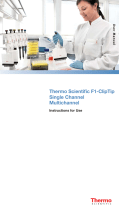 Thermo Fisher Scientific F1-ClipTip Pipetting System Owner's manual
Thermo Fisher Scientific F1-ClipTip Pipetting System Owner's manual
-
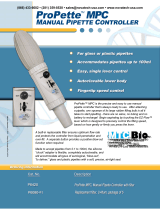 MTC Bio MTC-P6420 Owner's manual
MTC Bio MTC-P6420 Owner's manual
-
 AND AX-ST-ACR User manual
AND AX-ST-ACR User manual
-
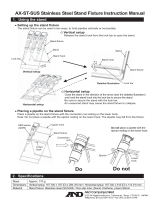 AND AX-ST-SUS User manual
AND AX-ST-SUS User manual
-
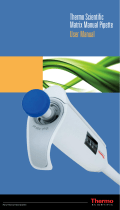 Thermo Fisher Scientific Matrix User manual
Thermo Fisher Scientific Matrix User manual
-
Arcam DIVA P1000 Owner's manual
-
Arcam DIVA P1000 User manual
-
Mettler Toledo Pipette Check Operating instructions
-
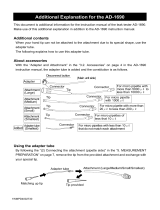 AND AD-1690 User manual
AND AD-1690 User manual




















